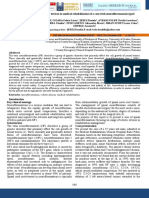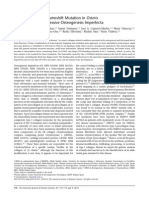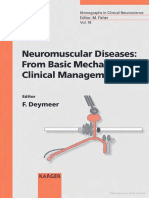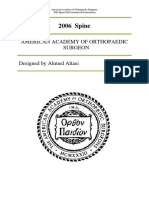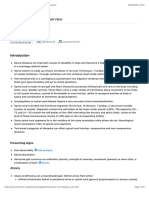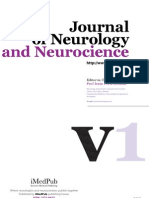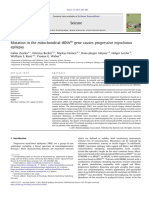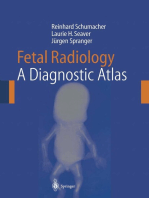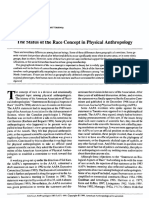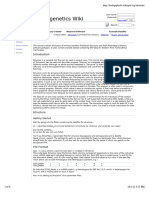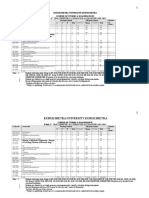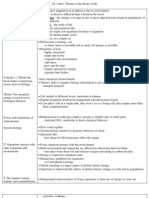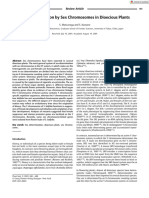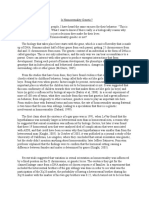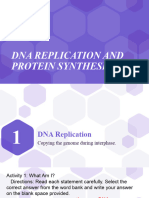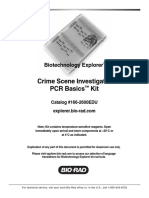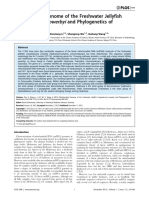ATROFIA MUSCULAR ESPINAL Lancet 2008
ATROFIA MUSCULAR ESPINAL Lancet 2008
Uploaded by
Sebastián Silva SotoCopyright:
Available Formats
ATROFIA MUSCULAR ESPINAL Lancet 2008
ATROFIA MUSCULAR ESPINAL Lancet 2008
Uploaded by
Sebastián Silva SotoOriginal Description:
Copyright
Available Formats
Share this document
Did you find this document useful?
Is this content inappropriate?
Copyright:
Available Formats
ATROFIA MUSCULAR ESPINAL Lancet 2008
ATROFIA MUSCULAR ESPINAL Lancet 2008
Uploaded by
Sebastián Silva SotoCopyright:
Available Formats
Seminar
Spinal muscular atrophy
Mitchell R Lunn, Ching H Wang
Lancet 2008; 371: 212033 Department of Medicine, Stanford University School of Medicine, Stanford, CA, USA (M R Lunn BS); and Department of Neurology and Neurological Sciences, Pediatric Neurology Division, Stanford University Medical Center, Stanford, CA, USA (C H Wang MD) Correspondence to: Dr Ching H Wang, Department of Neurology and Neurological Sciences, Pediatric Neurology Division, Stanford University Medical Center, 300 Pasteur Drive, Room A343, Stanford, CA 94305-5235, USA wangch@stanford.edu
Spinal muscular atrophy is an autosomal recessive neurodegenerative disease characterised by degeneration of spinal cord motor neurons, atrophy of skeletal muscles, and generalised weakness. It is caused by homozygous disruption of the survival motor neuron 1 (SMN1) gene by deletion, conversion, or mutation. Although no medical treatment is available, investigations have elucidated possible mechanisms underlying the molecular pathogenesis of the disease. Treatment strategies have been developed to use the unique genomic structure of the SMN1 gene region. Several candidate treatment agents have been identied and are in various stages of development. These and other advances in medical technology have changed the standard of care for patients with spinal muscular atrophy. In this Seminar, we provide a comprehensive review that integrates clinical manifestations, molecular pathogenesis, diagnostic strategy, therapeutic development, and evidence from clinical trials.
Introduction
Spinal muscular atrophy, the leading genetic cause of infant deaths, is an autosomal recessive disease that results from degeneration of motor neurons of the spinal cord. The incidence of spinal muscular atrophy is about one in 10 000 livebirths with a carrier frequency of one in 50.1,2 There is no eective medical treatment for spinal muscular atrophy. However, since the discovery of the disease-causing genesurvival motor neuron 1 (SMN1)substantial progress in understanding the molecular pathogenesis of this disease has been made. With this knowledge, innovations have generated excitement about the imminent development of treatment options. These and other advancements in medical technology have changed the standard of care for patients with this debilitating disease.
Clinical manifestations
Spinal muscular atrophy is characterised by degeneration of motor neurons of the spinal cord, which results in hypotonia and muscle weakness. Previously, diagnosis was conrmed by electromyography and muscle biopsy. Electromyography characteristic of the disorder shows features of denervation with spontaneous activity of positive sharp waves, brillation, and occasional fasciculations.3,4 Motor unit action potential shows high amplitudes and long durations coupled with decreased recruitment. Histopathology of skeletal muscle usually shows atrophic bres with islands of group hypertrophy,3 and the spinal cord shows severe loss of motor neuron in the anterior horn region (gure 1). Spinal muscular atrophy was previously divided into three clinical types on the basis of age of onset and motor function achieved: (1) severe type I; (2) intermediate type II; and (3) mild type III.5 Adult-onset type IV has been added to include very mild disease (table 1).6,7 Most researchers dene spinal muscular atrophy type by the highest level of motor functionie, sitter, walker. Type I disease (Werdnig-Homann disease) is the most severe and common type, which accounts for about 50% of patients diagnosed with spinal muscular atrophy.8 It is distinguished by the onset of disease before 6 months of age and death within the rst 2 years of life. These patients have profound hypotonia, symmetrical accid
2120
paralysis, and no control of head movement. They are unable to sit without support. The spared diaphragm, combined with weakened intercostal muscles, results in paradoxical breathing (inward bony thorax movement with outward abdominal movement during inspiration) and a bell-shaped upper torso. Bulbar denervation results in tongue fasciculation and weakness with poor suck and swallow. It also decreases airway protection and increases the risk of aspiration pneumonia, an important cause of morbidity and mortality. Type II disease is of intermediate severity and characterised by onset between 7 and 18 months of age. Patients are able to maintain a sitting position unaided. A few are able to stand with leg braces, but none can walk independently. Kyphoscoliosis usually develops, requiring surgical or orthotic intervention. Fine tremors with digit extension or hand grips are also common. Weak swallowing might deter weight gain. Like patients with type I disease, clearing of tracheal secretions and coughing might become dicult because of poor bulbar function and weak intercostal muscles. Respiratory insuciency is a frequent cause of death during adolescence. Patients with type III spinal muscular atrophy (Kugelberg-Welander disease) show profound symptom heterogeneity. They typically reach all major motor milestones, such as independent walking. Some might need wheelchair assistance in childhood, whereas others might continue to walk and live productive adult lives with minor muscular weakness. These patients often develop scoliosis. Symptoms of joint overuse, generally caused by weakness, are frequently seen. Patients with type IV disease typically have onset of weakness in the
Search strategy and selection criteria We searched for all publications containing spinal muscular atrophy, SMA, survival motor neuron, and survival of motor neuron. We included all relevant papers after 2000, but seminal reports, regardless of their publication date, were also included. We reviewed papers published in English, German, Italian, Japanese, Russian, and Spanish, but included only those published in English.
www.thelancet.com Vol 371 June 21, 2008
Seminar
second or third decade of life. Motor impairment is mild without respiratory or nutritional problems, and patients are able to walk in adult years. Other forms of spinal muscular atrophy include X-linked disease, spinal muscular atrophy with respiratory distress (SMARD), spinal and bulbar muscular atrophy (Kennedys disease), and distal spinal muscular atrophy, which are beyond the scope of this Seminar.
Normal
SMA
Molecular genetics and pathogenesis
In 1990, investigators used linkage analysis to identify the locus of the SMA gene on chromosome 5q13.9,10 The initial 10 cM interval was later narrowed to a 12 cM region with recombinant mapping.1113 Cloning of the disease-gene region with yeast articial chromosomes identied multicopy repeats of microsatellites (eg, CMS1, C212, C272) and other genomic sequences (gure 2). This unstable region was subjected to intrachromosomal rearrangements, including gene duplications, gene conversions, and de-novo deletions.1416 This complex genomic organisation greatly hindered the initial progress of cloning the disease gene.11,15 In 1994, researchers identied deletions of multicopy microsatellites in patients with spinal muscular atrophy;15 some of which were in linkage disequilibrium with the disease locus.17 Despite the genomic complexity in this region, Melki and colleagues15 uncovered a small 11 kb fragment that uniquely hybridised to a telomeric repeat that was missing in patients, thereby further narrowing the candidate region. A human fetal brain cDNA library was probed by genomic DNA from the candidate region, and the SMN gene was identied as the disease-causing gene in 1995.18 The SMN gene is present in multiple copies in the human genome: one SMN1 (SMNT, telomeric) and several SMN2 (SMNC, centromeric). The two genes dier by only ve nucleotides, only one of which is within the 17 kb coding region, but none aect the predicted aminoacid sequence.18,19 Both genes contain nine exons and eight introns that span about 20 kb genomic region. SMN1 encodes a 38 kDa protein with 294 aminoacids. The SMN protein is expressed in all somatic tissues and is highly conserved from yeast to man.2022 The SMN gene duplication found in primates took place after the split of primates from rodents, since mice have only one copy, which is denoted Smn. SMN2, however, is unique to man because chimpanzees do not have this gene signature despite having multiple SMN gene copies in their genome.23 More than 98% of patients with spinal muscular atrophy have a homozygous disruption of SMN1 by deletion, rearrangement, or mutation.18,24 All these patients, however, retain at least one copy of SMN2. This gene undergoes alternative splicing and produces a truncated mRNA isoform in which exon seven (major product) or exon ve, or both, are absent. A C-to-T nucleotide transition at position six of exon seven (Ex7+6) is responsible for the alternatively spliced isoform with
www.thelancet.com Vol 371 June 21, 2008
*
Normal SMA
Figure 1: Histopathology of spinal muscular atrophy Motor commands generated in the cerebral cortex are transmitted through spinal cord -motor neurons (red cell in spinal cord anterior horn and green arrow in (A). The spinal cord anterior horn region shows an absence of motor neurons in a patient (B) compared with those in the healthy control (A). Skeletal muscle of a patient (D) shows hypertrophic bres (hollow arrowhead) surrounded by group atrophy (green arrowhead) compared with healthy bres with uniform morphology in normal infantile muscle (C). Despite the atrophy of muscle bres in spinal muscular atrophy, muscle spindles (black asterisk) are not aected and become more conspicuous (D). All slides are stained with haematoxylin and eosin. OMIM Age at onset number Type I (severe, Werdnig-Homann disease) 253300 Type II (intermediate) Type IV (adult) 253550 271150 Type III (mild, Kugelberg-Welander disease) 253400 06 months >18 months Second or third decade Highest function Natural age achieved of death Never sit Stand and walk Walk during adulthood <2 years >2 years Adult Adult
718 months Sit, never stand
OMIM=Online Mendelian Inheritance in Man.
Table 1: Classication criteria for spinal muscular atrophy
no exon seven (gure 3).25,26 The resultant SMN7 protein is non-functional and thought to be rapidly degraded.25,27,28 About 10% of SMN2 pre-mRNA is properly spliced and subsequently translated into full-length SMN protein.18 However, the eciency of SMN2 splicing might be dependent on severity of disease, and production of a full-length transcript of SMN2 could range from 10% to 50%.29 This low level of SMN protein allows embryonic development, but is not sucient to sustain the survival of motor neurons of the spinal cord. In 2002, Cartegni and Kranier30 reported that the C-to-T nucleotide transition at Ex7+6 in SMN2 disrupts the
2121
Seminar
Centromeric copy
CATT1 CMS1 CATT1 C272 C171 AG1CA C212 C212
Telomeric copy
C272 AG1CA C171 CATT1 CMS1
Cen
GTF2H2
NAIP
SMN2
SERF1
SERF1
SMN1
NAIP
GTF2H2
Tel
SMA genetic map on chromosome 5q13
Figure 2: Genetic map of the spinal muscular atrophy locus SMN gene copies are contained within two large inverted genomic fragments (black horizontal lines) within this region on chromosome 5q13. SMN1 (blue) is located within the telomeric copy whereas at least one SMN2 (blue) is contained within the centromeric copy. Other genes in the vicinity of SMN copies are shown in black. Blue and red arrows denote the direction of transcription of SMN and other genes, respectively. Multicopy microsatellite markers (red) are indicated within these genomic repeats.
SR U2 U2 snRNP AF SF2 ASF SR Tra2 ESE
hn
SMN1
PA
(A)n
100%
6 7 8
(A)n
RN
CAGACAA ~10%
SR Tra2
hn RN hn P A1 RN hn P A RN 1 PA 1
PA 1
U2 U2 snRNP AF
UAGACAA
Figure 3: Pre-mRNA splicing of SMN1 and SMN2 In SMN1, an exonic splicing enhancer (ESE), which contains the nucelotide cytosine (C) at position six in exon seven (Ex7+6), is recognised by splicing factor 2 or alternative splicing factor (SF2/ASF), which interacts (thick black arrow) with the U2 class of small nuclear ribonuclear protein (U2 snRNP) to remove intron six. Other splicing factors (eg, Tra2) determine splicing through interactions (thin black arrow) with ESE elements found centrally within exon seven. Serine and arginine (SR)-rich proteins might also exert a positive splicing eect. In SMN2, the ribonucleotide uridine (transcribed from thymidine) at Ex7+6 favours exon seven exclusion by binding to heterogeneous nuclear ribonuclear protein (hnRNP) A1, a negative splicing factor. Moreover, SF2/ASF no longer recognises this sequence motif. Binding of hnRNP A1 is also believed to prohibit U2 snRNP binding to the branch point, which results in about 90% of SMN2 nal mRNA transcripts with no exon seven. The positive splicing factors downstream (thin black arrow) are functioning and could account for exon seven inclusion in about 10% of SMN2 transcripts.
hn
SMN2
RN
ESE
(A)n
~90% 6 8
(A)n
function of an exonic splicing enhancer sequence, which helps to promote normal splicing needed for production of intact SMN protein. This putative exonic splice enhancer sequence motif scored high for being dependent on splicing factor 2 (SF2), a positive splicing factor that is also known as the alternative splicing factor (ASF). The SF2/ASF interacts with the U2 class of small nuclear ribonuclear protein (U2 snRNP) and its auxiliary factor (U2AF) at the branch point within intron six to help with removal of the intron and successful pre-mRNA splicing during SMN1 transcription (gure 3). Reconstruction of this SF2/ASF-dependent exonic splice enhancer, by reverting the thymidine on Ex7+6 in SMN2 gene to cytosine, restored SMN2 splicing to include exon seven.30 Kashima and Manley31 challenged the exonic splice enhancer hypothesis, and argued that the C-to-T nucleotide transition in exon seven creates an exonic splice suppressor (ESS) in SMN2, which favours
2122
exclusion of exon seven by binding heterogeneous nuclear ribonuclear protein (hnRNP) A1 (a known splicing repressor protein). Kashima and others32 showed that C-to-T transition in SMN2 increases hnRNP A1 binding. The recruitment of hnRNP A1 might sterically prevent the formation or stabilisation, or both, of the snRNP complex needed for proper splicing. Disruption of this hnRNP A1-dependent ESS with mutations or RNA interference (RNAi) techniques restored SMN2 splicing to include exon seven but had no eect on SMN1.31 This restoration of exon seven inclusion in SMN2 is specic to SMN.32 An A-to-G transition in intron seven (In7+100) in SMN2 might create a second hnRNP A1 binding site to assist further in the exclusion of exon seven.33 In an eort to combine both theories, Cartegni and colleagues34 showed that hnRNP A1 might antagonise the SF2/ASF exonic splice enhancer eect to promote exclusion of exon seven, especially in SMN2, where this exonic splice enhancer is inactivated. However, the exact mechanism
www.thelancet.com Vol 371 June 21, 2008
Seminar
surrounding exon seven inclusion or exclusion during pre-mRNA splicing remains debatable. SMN protein is expressed in the cytoplasm and nucleus in all somatic tissues with particularly high amounts in motor neurons of the spinal cord.35,36 Within the nucleus, this protein localises to several small (0120 m diameter), punctate structures associated with coiled (Cajal) bodies named gems (gemini of coiled bodies).37,38 Although the exact cellular function of gems remains unknown, cells from patients with spinal muscular atrophy contain substantially fewer gems than do those in gene carriers and controls without the disease.36,39 In eukaryotic cells, the spliceosome is the cellular organelle that executes post-transcriptional pre-mRNA splicing. Uridine-rich snRNPs (U snRNPs), the principal components of spliceosomes, recognise highly conserved sequences and ligate exons. SMN protein, part of a highly stable complex with at least eight other proteins,40 is necessary and sucient for proper assembly of Smith class core proteins in the U snRNP.41,42 A point mutation (E134K) in the SMN tudor domain, the region that mediates Smith class protein assembly,43 can cause the disease by aecting the charge distribution in the SMN-Smith class binding site.44 SnRNP assembly activity is high during embryonic and postnatal development but decreases after myogenic and neuronal dierentiation. Transcriptional networks involving many genes that regulate cellular dynamics (eg, cell-cycle progression) are highly active during this time.45,46 This RNA transcriptional burden might need high amounts of snRNPs to accomplish processing of RNA. Inhibition of snRNP biogenesis by defective SMN protein might cause motor neuron degeneration seen in patients with spinal muscular atrophy. Winkler and co-workers47 noted that impaired U snRNP biosynthesis in both frog (Xenopus laevis) and zebrash (Danio rerio) embryonic models induced degeneration of motor neurons similar to that seen in spinal muscular atrophy despite rather normal development. Gabanella and others48 showed that Smn/;SMN2+/+ mice have an eight-fold decrease in SMN protein and a ten-fold decrease in snRNP assembly activity in the brain and spinal cord compared with normal (Smn+/+;SMN2+/+) mice. Although SMN protein is expressed in all somatic cells, why motor neurons of the spinal cord are specically vulnerable in spinal muscular atrophy is puzzling. that SMN protein might have an Studies suggest important part in certain cellular functions that are unique to motor neurons. Investigators noted that this protein was localised in ribonucleoprotein granules in the neurites and growth cones of primary motor neurons, and in motor neurons derived from embryonic stem cells.49,50 Live-cell uorescence microscopy was used to observe active bidirectional transport of these granules to neuronal processes and growth cones.50 SMN protein also interacts with hnRNP R and Q.51,52 hnRNP R interacts with the 3 untranslated region of -actin mRNA.51 Low
www.thelancet.com Vol 371 June 21, 2008
concentration of SMN protein resulted in low titres of -actin mRNA and protein in axons and growth cones,53 suggesting that SMN protein might be involved in transportation of ribonucleoprotein complexes containing -actin. Deciency of -actin results in axonal outgrowth and pathnding defects in two neuronal culture models54 and in a zebrash model of spinal muscular atrophy.55 Prolin, an actin-binding protein, regulates actin dynamics through sequestration and release of actin monomers. SMN protein colocalises with prolin IIa (the predominant isoform in neuronal tissue56) as distinct granules in neurite-like extensions and growth cones.57 Mutant SMN protein fails to interact with prolin IIa, and knocking down prolin IIa alone inhibits neurite outgrowth.57 Setola and colleagues58 reported the identication of a novel SMN isoform named axonal-SMN that is preferentially transcribed from SMN1 and includes intron three. The repetitive polyadenine tract of this intron was unexpectedly resistant to mutations, which would alter the C-terminal protein structure, suggesting that this sequence might be needed for the structure or function, or both, of axonal-SMN.59 The axonal-SMN protein was not detected in the glia or grey matter outside Rexeds lamina IX (motor neuron area) in the spinal cord.58 Several groups have made disease models in Drosophila melanogaster that show neuronal and muscular defects.60,61 These models have led to postulation of roles for SMN protein at the neuromuscular junction61 and in skeletal muscle.60 These data suggest that SMN protein might sustain the survival of motor neurons by allowing normal axonal transport and maintaining the integrity of neuromuscular junctions. Low concentrations of SMN protein might be specically detrimental to motor neurons because of the long axons and their unique interactions with skeletal muscles. The mouse Smn gene, located on chromosome 13, contains nine exons like the human SMN gene and is 83% homologous to the SMN1 open reading frame.62,63 No alternative splicing isoform exists since only a full-length 14 kb transcript has been noted. Creating a mouse with spinal muscular atrophy was challenging because homozygous deletion of murine Smn (Smn/) is lethal at the embryonic stage,20 whereas heterozygous Smn+/ mice are phenotypically normal. These early failures suggested that more innovative approaches were needed to establish a mouse model of the disease. In the past 7 years, several dierent models of spinal muscular atrophy have been developed in mice.64 Taiwanese scientists used the observation that patients with this disease always have at least one copy of SMN2 and created a transgenic (Tg) mouse with human SMN2.65 Smn+/ mice were crossed with Smn+/;TgSMN2 mice to produce Smn/;TgSMN2, with clinically and histopathologically similar spinal muscular atrophy to that in people. Similar strategies were used by other groups to create model mice that mimicked human spinal muscular atrophy with varying severities in
2123
Seminar
clinical symptoms and histopathology.6668 Smn/;TgSMN2 produced in dierent laboratories64,67 have varying phenotypes, presumably because of dierent genetic backgrounds, dierent allelic knockouts, or dierent sizes of transgene regions. By purifying the genetic background to standardise the number of SMN2 copies, a mouse with type III spinal muscular atrophy with no phenotypic heterogeneity was created.69 Tissue-specic knockdown of SMN protein has also been accomplished in neurons70 or muscle,71,72 by anking Smn with loxP sequences (oxed) and expressing Cre recombinase under a neuronal-specic or muscle-specic promoter. Expression of Cre recombinase results in ecient deletion of oxed genes by homologous recombination. Constitutive overexpresssion of SMN protein has also been accomplished in neuronal and skeletal muscle tissue.73 Gavrilina and others73 showed that neuronal overexpression signicantly prolonged Smn/;SMN2+/+ mice, but overexpression in skeletal muscle had no
eect. Butchback and colleagues74 created an Smn/;SMN2+/+;SMN7+/+ mouse whose phenotype is slightly less severe (lifespan 1415 days).64,67
Clinical implications of cloning SMN genes
Identication of the SMN genes not only enabled further research into the molecular pathogenesis of spinal muscular atrophy, but also allowed rapid and sensitive diagnosis. Figure 4 shows the algorithm for diagnosis of the disease by molecular genetic methods. Patients with a clinical presentation resembling spinal muscular atrophy should be tested for homozygous deletion of the SMN1 gene, which is 95% sensitive and about 100% specic.75,76 Two diagnostic tests exist: a combined PCR with restriction enzyme digestion assay77,30 and an allelespecic PCR assay of the SMN1 and SMN2 PCR products.78,79 The rst method uses dierential susceptibility of the SMN1 and SMN2 PCR products to endonuclease digestion. The allele-specic PCR assay
SMA with typical or atypical clincial features
SMN1 gene deletion test
Homozygous SMN1 deletion detected
5q SMA diagnosis conrmed
Homozygous SMN1 deletion not detected
Repeat clinical examination, EMG, NCS, and CK
Demyelinating or axonal neuropathy, NMJ disorder, myopathy, muscular dystrophy
Atypical SMA features, neurogenic electromyography, normal CK
Diuse weakness, normal electromyography, normal CK, normal NCS
Proximal > distal weakness, neurogenic electromyography, normal CK
Consider muscle or nerve biopsy; genetic tests for myopathies, muscular dystrophies, and neuropathies
Consider other motor neuron disorders (SMARD, X-linked SMA, distal SMA, ALS)
Consider brain or spinal cord MRI; metabolic screens
SMN1 gene copy count
One SMN1 copy
Two SMN1 copies
SMN1 gene sequencing
SMN1 mutation found
No SMN1 mutation found
5q SMA diagnosis conrmed
SMN-related SMA diagnosis remains unconrmed
Figure 4: Diagnostic algorithm for spinal muscular atrophy Any patient presenting with clinical symptoms resembling spinal muscular atrophy (SMA) should be tested for homozygous deletion of SMN1, which would conrm the diagnosis of SMN-associated SMA (5q SMA). A negative SMN1 test should be followed with a repeat clinical examination for atypical clinical features (eg, contractures, eventration of hemidiaphragms, congenital absence of muscles, pes equines deformity) and laboratory testing for creatinine phosphokinase (CK) and electrophysiological studies such as electromyography (EMG) and a nerve conduction study (NCS). If lower motor neuron disease is suggested by EMG, SMN1 copy number will establish if SMN1 sequencing is indicated to identify intragenic mutations in patients with a single SMN1 copy. When two SMN1 copies are detected, then investigation should be directed towards other motor neuron diseases by further diagnostic work-up such as muscle or nerve biopsy, imaging studies, metabolic screens, and genetic testing. ALS=amyotrophic lateral sclerosis. NMJ=neuromuscular junction. SMARD=SMA with respiratory distress. Red boxes=diagnostic assessments. Blue boxes=physical and laboratory ndings. Green boxes=nal diagnoses.
2124
www.thelancet.com Vol 371 June 21, 2008
Seminar
uses the nucleotide variation in exon seven and specically designed PCR primers to quantitatively amplify SMN1 or SMN2. Both tests conrm a diagnosis of 5q spinal muscular atrophy, but the second one provides a quantitative measure of SMN1 copy number. In cases in which a single copy of SMN1 is detected, further investigation into SMN1 intragenic mutations by gene sequencing is warranted. When two SMN1 copies are detected, further diagnostic studies should investigate other motor neuron, brain, spinal cord, and neuromuscular junction diseases (gure 4). The phenotypic heterogeneity of spinal muscular atrophy is striking considering that nearly all patients have a defect in the same SMN1 gene. After initial hypotheses that the disease phenotype correlates with the size of the genomic deletion,80 a thorough search of this unstable genetic region revealed multiple SMN2 copies in the human genome,81,82 possibly caused by gene duplication or conversion events, or both.16,83 Investigation with Smn/ mice showed that adding a human SMN2 transgene could rescue pups from early embryonic death,20 and eight copies of human SMN2 could produce a phenotypically normal mouse.67 Other studies in man also showed that a higher number of SMN2 copies correlates with milder phenotypes.81 However, variations in phenotypes are common with any number of SMN2 copies. Therefore, prediction of the spinal muscular atrophy phenotype with SMN2 copy number is not recommended. Some evidence suggests that other phenotype-modier geneseg, GTF2H2 (BTF2P44), SERF1A (H4F5)might exist.84,85 Evidence also suggests that higher amount of SMN protein is observed in patients with milder form of spinal muscular atrophy.86 High homology between SMN1 and SMN2 complicated carrier detection with PCR methods, because amplication of an SMN1 fragment frequently amplies SMN2 as well. Initial carrier detection methods used high sensitivity densitometry of PCR products to identify copy number.82 Present methods use quantitative real-time PCR allowing measurement of both SMN1 and SMN2 copy number separately.78,80,87,88 However, the SMN1 copy number test might rarely and inaccurately determine the carrier status, because about 32% of the general population has both SMN1 copies on one chromosome and none on the other (denoted 2+0).89,90 These people are carriers because one of their chromosomes is missing a normal SMN1 allele. Another 17% have intragenic mutations that are not detectable by these methods of SMN1 dosage analysis.80 SMN1 gene sequencing can detect intragenic mutations, and 2+0 carriers can be detected by karyotyping with uorescence in-situ hybridisation. Chorionic villi sampling and amniocentesis can eectively nd out the fetal genotype.91,92 Additionally, circulating fetal cells in maternal blood can be isolated by isolation by size of epithelial tumour or trophoblastic cells (ISET) for PCR-based genetic analysis.93 For those
www.thelancet.com Vol 371 June 21, 2008
who do not want to wait for the decision until early pregnancy, in-vitro fertilisation allows several blastomeres to be tested for SMN1 deletion after growth in culture. After the allele-specic PCR assay of a single cell is done, unaected embryos can be implanted.9496 This procedure requires high technical precision and is available only at select centres. Treatments to prevent motor neuron death will presumably have the greatest eect before onset of disease. The challenge, however, is the identication of these patients before they are symptomatic. Carrier parents are asymptomatic, and most children with spinal muscular atrophy appear normal for the rst few months of life. Newborn screening could address this challenge, but it has not become standard practice because without eective treatment this practice is not justied. A study assessed the eectiveness of genetic screening for SMN1 in neonates with real-time quantitative PCR on 153 dried blood spots on lter paper.97 With 100% specicity and sensitivity, this study provided evidence of the feasibility for large-scale newborn screening. However, social, ethical, and political implications, as well as implementation of procedures and treatment protocols, will need to be suciently addressed before screening of newborn babies can be advocated.
Treatment
One substantial implication of uncovering the molecular genetic basis of spinal muscular atrophy is in the development of candidate therapeutics. The unique genomic organisation of the SMN genes allows a novel therapeutic approach: to promote SMN2, existing in all patients, to function like the missing SMN1 gene. This idea prompted investigations into increasing inclusion of exon seven in SMN2 mRNA transcripts,39,98101 upregulation of SMN2 transcription by promoter activation,102104 modulation of SMN protein translation,105107 and prevention of SMN protein degradation.28,108 Serinearginine-rich proteins are splicing factors that interact with exonic splice enhancers and aect mRNA splicing. Htra2-1, a serinearginine-rich-like splicing factor, was found to stimulate full-length SMN2 expression109 by interacting with exonic splice enhancers, especially elements that contain AG-rich motifs such as positive splicing enhancer 2.26 Abrogation of such motifs results in skipping of exon seven.26 Little is known about the importance of Htra2-1, and SMN genes are the only known human genes whose splicing is specically regulated by Htra2-1; other human isoforms (eg, Htra2-3 and Htra2-) did not stimulate proper SMN2 splicing.109 The use of pharmacological compounds to upregulate Htra2-1 might prove to be a valuable strategy to modulate SMN2 splicing. One of the rst candidate treatments for spinal muscular atrophy was aclarubicin (aclacinomycin A), an anthracycline and topoisomerase II inhibitor used in patients with solid tumours or leukaemia. Aclarubicin was discovered by screening a 960-member combinatorial
2125
Seminar
chemistry library with a semiquantitative assay based on RT-PCR to detect inclusion of exon seven.99 Aclarubicins toxicity prohibited further development for clinical use to treat patients with spinal muscular atrophy. Nevertheless, it served as a proof of principle for identifying modiers of SMN2 splicing and that high throughput screening was a valid approach to identify candidates. With histone acetylation, the surrounding DNA relaxes and is accessible to transcriptional machinery. Inhibition of histone deacetylation might enhance expression in about 2% of human genes.110 Sodium butyrate was the rst histone deacetylase inhibitor found to enhance SMN2 expression and increase exon seven inclusion in lymphoid cell lines derived from patients with spinal muscular atrophy. This treatment also increased expression of SMN protein in the spinal cord and motor neurons of SMA-like mice developed by the Taiwanese researchers described previously.99 Not surprisingly, the expression of other genes (eg, globin) was also increased. However, the short half-life, about 6 min in human serum, prohibited sodium butyrate from substantial clinical development. Encouraged by the eect of sodium butyrate, the search began for other putative histone deacetylase inhibitors. In 2003, two groups reported that valproic acid, a histone deacetylase inhibitor approved for epilepsy treatment, increased full-length SMN mRNA. Valproic acid activated the SMN2 promoter and induced expression of positive splicing factors, SF2/ASF and Htra2-1.100,101 In 2004, Andreassi and colleagues103 reported that a sodium butyrate derivative, phenylbutyrate, increased full-length transcript production from SMN2, SMN protein, and the number of nuclear gems. Phenylbutyrate is still used to treat children with ureacycle defects and has a slightly longer half-life (0810 h in human serum) than has sodium butyrate.111 Further investigations were directed towards more potent and specic histone deacetylase inhibitors. Suberoylanilide hydroxamic acid, a potent histone deacetylase inhibitor under clinical investigation for cancer therapy,112 has good oral bioavailability and is non-toxic, despite complete inhibition.113 At low micromolar concentration, suberoylanilide hydroxamic acid activated the SMN2 gene in broblasts from patients and increased SMN protein in rat motor neuron cultures, and in both human and rat hippocampal brain slice cultures.113 Another potent hydroxamic acid, trichostatin A, was originally isolated in 1976 as an antifungal drug,114 but it has not been in clinical use because of the high cost of isolation and purication. Treatment with trichostatin A in normal and SMN7 mouse models specically increased properly spliced SMN2 transcript, snRNP assembly, and SMN protein in neural and muscle tissue.115 Even after the onset of disease, trichostatin A treatment was able to extend survival and increase the size of myobres and spinal cord motor neurons in the SMN7 mouse model. Jarecki and colleagues104 screened
2126
550 000 compounds in a -lactamase assay designed to detect activation of the SMN2 promoter. They discovered ve classes of compounds that altered SMN2 transcript. Four of these increased the full-length to truncated SMN2 transcript ratio. Two also increased SMN protein and the number of nuclear gems in broblasts from type I patients. Further medicinal chemistry and structureactivity relationship studies will assess the promise of these molecules in clinical use. Grzeschik and colleagues39 noted that hydroxyurea, a ribonucleotide reductase inhibitor, increased the full length to truncated SMN mRNA ratio. The total amount of SMN mRNA in the lymphoblastoid cell lines from patients with spinal muscular atrophy was not changed after hydroxyurea treatment, but the increase in full-length SMN mRNA was coupled by a decrease in truncated SMN mRNA. This nding shows that hydroxyurea increased the full-length SMN mRNA by promoting exon seven inclusion rather than activating the SMN2 promoter.39 Furthermore, hydroxyurea treatment, in vitro, increased SMN protein and the number of nuclear gems. Hydroxyurea also has a good safety prole, easy oral administration, and high bioavailability. Riluzole is a neuroprotective agent known to promote neuronal survival through glutaminergic antagonism.116 Haddad and colleagues117 treated special spinal muscular atrophy mice with Smn exon seven deleted only in neurons and found that riluzole extended lifespan but did not signicantly improve function. It prevented aberrant cytoskeletal organisation at the motor terminals but did not prevent loss of proximal axons.117 After screening about 47 000 compounds, Lunn and others107 discovered that indoprofen, a non-specic cyclo-oxygenase inhibitor and a non-steroidal anti-inammatory drug, increased SMN protein in broblasts of patients with type I spinal muscular atrophy. It also increased the number of nuclear gems and caused a trend towards increased viability in the Smn/;TgSMN2 spinal muscular atrophy mouse model.107 No other non-steroidal anti-inammatory drugs that were tested showed a similar eect, suggesting that indoprofens eect is independent of cyclo-oxygenase inhibition. A previously approved drug in the UK, indoprofen, was removed from the market because of high frequency of gastrointestinal bleeding secondary to cyclo-oxygenase inhibition. Other compoundseg, a -adrenergic agonist,118 an Na+/H+ exchanger inhibitor,119 and polyphenol plant compounds120have been reported to promote exon seven inclusion and to increase SMN protein concentration in broblasts derived from patients with spinal muscular atrophy. Translation of SMN1 mRNA ends at a stop codon at the end of exon seven with no translation of exon eight. The 16 aminoacids absent in SMN7 protein, although not a direct mediator of SMNs numerous activities, are believed to be required for oligomerisation of SMN protein.121,122 Heterologous sequences are able to substitute123 for the cytoplasmic localisation signal of SMN protein.50 Since aminoglycosides have been reported
www.thelancet.com Vol 371 June 21, 2008
Seminar
to promote stop codon read-through,124 the Lorson group105,106 reported that various aminoglycosides increased the number of nuclear gems and full-length SMN protein by preventing recognition of stop codon in the SMN transcript; this read-through results in the addition of a non-specic tail needed for proper cytoplasmic localisation of the SMN gene and increased activity of SMN7 protein. Another way to modulate SMN2 splicing was to use exon-specic antisense oligonucleotides that were complementary to regions of SMN2 exon seven.125,126 Antisense oligonucleotides bound to pre-mRNA inhibited binding of negative splicing factors, which led
Design Acetyl-L-carnitine MC, randomisation, DB, PC SC, OL, PS SMA type II, III Sample size 110
to increased exon seven inclusion, the amount of SMN protein, and the number of nuclear gems in broblasts from patients with spinal muscular atrophy. Some bifunctional antisense oligonucleotides also have a non-complementary tail that is rich in potent exonic splice enhancer sequences to recruit trans-acting positive factors that might inhibit binding of negative splicing proteins.126 Antisense oligonucleotides were able to modulate splicing and inhibit signalling in a mouse study.127 Further investigations into bifunctional antisense oligonucleotides might increase potency but run the risk of being incompatible as a treatment option because of possible endogenous immunological
Primary outcome measure Handgrip and elbow exion strength Muscle strength, forced vital capacity, lean body mass GMFM Secondary outcome measure Knee exion strength, forced vital capacity, quality of life .. Results Completed, results pending Comments http://www.enmc.org/ workshop/?id=73 No placebo control, unblinded. Improvement could be due to normal growth No eect ..
Albuterol131
II, III
13 (5 type II, 8 type III)
Signicant increase in all outcome measures
Creatine Gabapentin136,140
MC, randomisation, PC MC, randomisation, DB, PC MC, randomisation, treatment vs non treatment
II, III II, III
55
Functional tests, Completed, results pending pulmonary function tests Forced vital capacity, SMA rating scale, minisickness impact prole Forced vital capacity, timed tests MUNE, SMN mRNA and protein MUNE, SMN mRNA and protein .. No dierence between treatment and placebo groups Improvement in leg strength and a trend for improvement in arm strength In progress In progress In progress
84 (40 treatment, Muscle strength 44 placebo) testing 120 (61 treatment, 59 no treatment) 18 (2:1 treated to placebo ratio) 24 (2:1 treated to placebo ratio) 60 Change in maximum voluntary isometric contraction Survival GMFM SMN mRNA and protein, motor function, lung function HFMS Tolerability SMN mRNA level
II, III
..
Hydroxyurea141
SC, PI or PII, randomisation, DB, PC SC, PI or PII, randomisation, DB, PC SC, PII, randomisation, DB, PC
I II or III II or III
ClinicalTrials.gov Identier: NCT00083746 ClinicalTrials.gov Identier: NCT00084006 ClinicalTrials.gov Identier: NCT00485511
SC, OL, PS Phenylbutyrate134136 MC, PI or PII, OL, PS SC, OL, PS
II, III II II, III
33 29 (10 treatment, 19 no treatment) 6 (4 type II, 2 type III) and 3 carriers 107 (54 treatment, 53 placebo) 30 30 12 20 10 (7 treatment, 3 placebo) 40 (targeted), 3 (completed)
SMN mRNA
Completed
.. .. ..
HFMS, myometry, forced Signicant increase in vital capacity HFMS scores .. Increased SMN mRNA level
MC, PII, randomisation, DB, PC MC, PI, OL MC, PI, OL SC, PI or PII, OL SC, OL, PS Riluzole139 MC, PI, randomisation, DB, PC MC, PI or II, OL
II II, III I II, III I, II I
HFMS Tolerability Tolerability Safety, tolerability Safety Survival
Myometry, forced vital capacity SMN mRNA and protein Pharmacokinetics, SMN mRNA and protein Overall motor function
No signicant improvement In progress In progress In progress
.. ClinicalTrials.gov Identier: NCT00439569 ClinicalTrials.gov Identier: NCT00439218 ClinicalTrials.gov Identier: NCT00528268 Trial prematurely stopped due to withdrawn nancial support .. (Continues on next page)
SMN mRNA and protein, Completed, results pending TIMP, HFMS .. No adverse event or serious adverse event attributed to treatment Completed, results pending
Survival
SMN mRNA
www.thelancet.com Vol 371 June 21, 2008
2127
Seminar
Design (Continued from previous page) Somatotropin MC, PII, randomisation, DB, PC, crossover SC, randomisation, DB, PC SC, OL, PS
SMA type
Sample size
Primary outcome measure
Secondary outcome measure
Results
Comments
II, III
20
Hand-held myometry Functional tests, pulmonary function testing Muscle strength using NCV, CMAP hand-held dynamometry ..
Not yet recruiting
ClinicalTrials.gov Identier: NCT00533221 Patient served as own control because of small sample size
Thyrotropinreleasing hormone (protirelin)142 Valproic acid137,138
II, III
9 (6 treatment, 3 placebo)
Improvement muscle strength and some CMAP/ NCV values
I, II, III
21 (5 type I, SMN2 mRNA level 10 type II, 6 type III) and 10 carriers 7 36 42 Hand-held dynamometry Muscle strength Tolerability
.. SMN2 mRNA increased in 7 patients with SMA, unchanged or decreased in 13 Strength improvement by 48% In progress .. ClinicalTrials.gov Identier: NCT00481013 ClinicalTrials.gov Identier: NCT00374075 ClinicalTrials.gov Identier: NCT00227266
SC, Retrospective, OL SC, PII, randomisation, DB, PC, crossover SC, PI or PII, OL, PS
III, IV Type III ambulatory I, II, III (>2 years) Cohort 1: sitting II and III; cohort 2: standing II and III
.. MUNE, lean body mass, timed tests
SMN mRNA and protein, Completed EMG, pulmonary function testing SMN mRNA, MUNE, CMAP, pulmonary function testing In progress
Valproic acid and L-carnitine
PII, randomisation, DB, PC, crossover
90 (in two cohorts) Safety, HFMS, myometry
The information contained in the ongoing studies was gathered through unpublished sources, and some might not be current or complete. CMAP=compound motor unit action potentials. DB=double-blind. GMFM=gross motor function measure. HFMS=Hammersmith functional motor score. MC=multicentre. MUNE=motor unit number estimation. NCV=nerve conduction velocities. OL=open-label. PC=placebo-controlled. PI=phase I. PII=phase II. PIII=phase III. PS=pilot study. SC=single centre. TIMP=test of infant motor performance.
Table 2: Completed and ongoing clinical trials of various therapeutic agents for spinal muscular atrophy
reactions. Cartegni and Krainer128 developed a peptide nucleic acid oligonucleotide mimetic that is resistant to nucleases and does not activate ribonuclease H on binding to the target RNA. High amounts of this nucleic acid mimetic increased exon seven inclusion in a three-exon (exon six through eight) mini-gene splicing reaction in vitro. This eect was sequence specic, because a peptide nucleic acid directed against another gene had no eect. DiMatteo and colleagues129 used single-stranded oligonucleotides to convert SMN2 into SMN1 in broblasts of patients with spinal muscular atrophy. The conversion was conrmed by quantitative RT-PCR and by proper intracellular SMN protein localisation.
Clinical trials
Many compounds noted to increase SMN mRNA and protein expression in vitro and in animal models in the past few years led to human studies of candidate therapeutics.130 Small-scale studies in man with candidate compounds that have no supporting preclinical data have met little success.131,132 Several clinical trials based on strong pre-clinical data are in progress. Early pilot studies of phenylbutyrate in patients with types II and III spinal muscular atrophy showed increases in full-length SMN expression and in motor function as measured by myometry and the Hammersmith functional motor scale.133,134 A randomised, double-blind, placebo-controlled trial of phenylbutyrate in 107 patients with type II disease
2128
at ten Italian centres, however, reported no signicant change in functional motor scores after 13 weeks of treatment.135 Similarly, a placebo-controlled, randomised, double-blind trial of gabapentin in types II and III patients showed no substantial dierence in muscle strength between treatment and placebo groups after 12 months of treatment.136 Treatment of patients with spinal muscular atrophy and disease-gene carriers with valproic acid in a pilot study resulted in an increase in full-length SMN expression, but no clinical outcome was measured.137 An open-label study of valproic acid in seven patients with mild disease (types III and IV) showed a rise in quantitative muscle strength by dynamometry and improved subjective motor functioning after a mean treatment duration of 8 months.138 Riluzole was tested in a phase I, randomised, double-blind, placebo-controlled study for patients with type I disease.139 Although this study lacked statistical power because of a small sample size, benet was suggested in treated patients. A multicentre randomised trial intended to further study the eect of riluzole in type I has been completed; however, the result is pending. Several randomised trials are in progress, including a multicentre trial with combined l-carnitine and valproic acid; two double-blind, placebo-controlled trials with hydroxyurea in type I and in types II or III patients; and a multicentre trial assessing the ecacy of somatotropin in type II and III patients. Table 2 lists the clinical trials completed and in progress.
www.thelancet.com Vol 371 June 21, 2008
Seminar
Conclusion
Future advances in high-throughput screening technologies, computation, and organic synthesis143 will allow development of specic, non-toxic, potent small molecules to modulate splicing and expression of SMN2. Government-backed programmes, such as the SMA Project, will accelerate these goals. Additionally, modulation of non-SMN targets (eg, Gemin2 and Gemin6) can aect SMN protein activity.144 Promising, alternative gene therapy approaches to modulate pathogenesis with viral vectors to deliver SMN1 directly,145 trans-splicing RNAs to correct SMN2 splicing,146 and neurotrophic agents (ie, cardiotrophin-1)147 should be explored. Motor neurons derived from stem cells have been established,148,149 and stem cells are promising for use in assays and human therapeutic trials. Neuronal stem cells proved to protect surviving motor neurons in rats with motor neuron injury.150 In an exciting report, embryonic stem cells derived from motor neurons survived in spinal cords of rats with motor neuron injury, and axons from these cells were
Panel: Databases and websites Databases Online Mendelian Inheritance in Man (NCBI/OMIM): http://www.ncbi.nlm.nih.gov/omim/ PubMed: http://www.pubmed.com Clinical trial networks in the USA American SMA Randomised Trial (AmSMART) Group: http://www.amsmart.org Pediatric Neuromuscular Clinical Research Network (PNCR): http://www.urmc.edu/sma Project Cure SMA: http://www.projectcuresma.org Clinical trial networks in Europe European Neuromuscular Centre (ENMC): http://www.enmc.org TREAT-NMD: http://www.treat-nmd.eu Clinical trial registry in the USA ClinicalTrials.gov: http://www.clinicaltrials.gov Patient and family advocacy groups The Benjamin Foundation: http://www.thebenjaminfoundation.org Families of SMA: http://www.fsma.org Fight SMA/Andrews Buddies: http://www.ghtsma.org Hope and Light Foundation: http://www.hopeandlight.org Miracle for Madison and Friends: http://www.miracleformadison.org Paytons Pals: http://www.paytonspals.com SMA Angels Charity: http://www.smaangels.org SMA Foundation: http://www.smafoundation.org SMA Support: http://www.smasupport.com Patient registry International SMA Patient Registry: http://www.iupui. edu/~medgen/hereditary/sma.html
noted in ventral roots.151 Moreover, these motor neurons formed neuromuscular junctions and induced contraction in vitro with cultured myoblasts. Future research would need to aim at delivering these stem cells derived from motor neurons to the spinal cord, countering host versus graft immunological responses, and guiding axonal outgrowth to reach the target muscles. As clinical trials have progressed, several challenges have surfaced.151 The small number of patients for clinical trials will need a coordinated eort for patients to participate in dierent trials. Criteria will need to be set up for the selection of compounds for clinical trials. Various elements of trial design will need to be unied to allow comparisons of results between trials. Sensitive and valid outcome measures will need to be developed.130 Few clinical outcome measures are available for patients with type I spinal muscular atrophy other than survival. Although myometry using hand-held dynamometers152 and quantitative muscle testing153,154 are reliable muscle strength measures in types II and III patients, these are not useful for type I patients. Functional motor scales, such as the Hammersmith functional motor scale and gross motor functional measurement, are also restricted to types II and III patients.155 Measuring the function of other organ systems, such as pulmonary function and ability to swallow and speak, might be sensitive outcome measures, especially in younger patient groups. Additionally, biomarkers, such as SMN mRNA and protein and gem count, might be sensitive outcome measures for clinical trials. The amounts of full-length SMN transcripts and SMN protein are well correlated with disease severity. As such, several groups have developed promising assays to monitor changes in SMN mRNA and protein in human blood.156,157SMN mRNA seems to be the most amenable to large multicentre trials.158 The clinical implications of elucidating the molecular genetic basis of spinal muscular atrophy and advances in medical technology have changed the clinical care of patients. However, these patients still receive highly diverse care for several reasons such as large clinical phenotypic variation, multiorgan system involvement, geographical variation in availability of medical expertise, dierent values of clinicians and families, and variations in nancial resources. Dierences in clinical care also hinder valid measures of clinical outcomes in clinical trials. The International Standard of Care Committee for spinal muscular atrophy was established in 2005 with a mission to set a standard of care. The committee consists of 12 core members and four working groups: diagnostics or new interventions, pulmonary, gastroenterology or nutrition, and orthopaedics or rehabilitation. Each working group contains eight to ten experts in that specialty. The groups identied few data that were available to establish evidence-based practice guidelines for the disease. Hence, a Delphi survey was used to achieve consensus among more than 60 experts from 12 countries. The committee held two meetings to draft a
For more on the SMA project see http://www.smaproject.org
www.thelancet.com Vol 371 June 21, 2008
2129
Seminar
consensus statement for the standard of care for patients.7 As a result, we hope that receiving consistent medical care will become easier for patients and that valid clinical outcomes can be measured during clinical trials. Although major challenges remain towards developing a therapeutic agent for patients with spinal muscular atrophy, our understanding of the disease biology, including several animal models, has grown exponentially since identication of SMN1 in 1995. Clinical trials have begun and have uncovered areas to improve the design of human studies and patient care (panel). Further research and development, coupled with a broadly accepted and applied standard of care for these patients, will help us manage, treat, and eventually cure this devastating neurodegenerative disease.
Conict of interest statement We declare that we have no conict of interest. We have no relation to any patent application or intellectual property for any spinal muscular atrophy therapeutic candidate. Acknowledgments We thank Rishi Bhatnagar for medical illustration and Hannes Vogel for providing histopathological slides. MRL is supported by the Molecular Basis of Medicine scholarly concentration at Stanford University School of Medicine. References 1 Pearn J. Classication of spinal muscular atrophies. Lancet 1980; 1: 91922. 2 Ogino S, Leonard DG, Rennert H, Ewens WJ, Wilson RB. Genetic risk assessment in carrier testing for spinal muscular atrophy. Am J Med Genet 2002; 110: 30107. 3 Buchthal F, Olsen PZ. Electromyography and muscle biopsy in infantile spinal muscular atrophy. Brain 1970; 93: 1530. 4 Emery AE, Hausmanowa-Petrusewicz I, Davie AM, Holloway S, Skinner R, Borkowska J. International collaborative study of the spinal muscular atrophies. Part 1. Analysis of clinical and laboratory data. J Neurol Sci 1976; 29: 8394. 5 Munsat TL. International SMA Collaboration. Neuromuscul Disord 1991; 1: 81. 6 Russman BS. Spinal muscular atrophy: clinical classication and disease heterogeneity. J Child Neurol 2007; 22: 94651. 7 Wang CH, Finkel RS, Bertini ES, et al. Consensus statement for standard of care in spinal muscular atrophy. J Child Neurol 2007; 22: 102749. 8 Markowitz JA, Tinkle MB, Fischbeck KH. Spinal muscular atrophy in the neonate. J Obstet Gynecol Neonatal Nurs 2004; 33: 1220. 9 Brzustowicz LM, Lehner T, Castilla LH, et al. Genetic mapping of chronic childhood-onset spinal muscular atrophy to chromosome 5q11.2-13.3. Nature 1990; 344: 54041. 10 Melki J, Abdelhak S, Sheth P, et al. Gene for chronic proximal spinal muscular atrophies maps to chromosome 5q. Nature 1990; 344: 76778. 11 Brzustowicz LM, Kleyn PW, Boyce FM, et al. Fine-mapping of the spinal muscular atrophy locus to a region anked by MAP1B and D5S6. Genomics 1992; 13: 99198. 12 Wang CH, Kleyn PW, Vitale E, et al. Renement of the spinal muscular atrophy locus by genetic and physical mapping. Am J Hum Genet 1995; 56: 20209. 13 Clermont O, Burlet P, Burglen L, et al. Use of genetic and physical mapping to locate the spinal muscular atrophy locus between two new highly polymorphic DNA markers. Am J Hum Genet 1994; 54: 68794. 14 Schmutz J, Martin J, Terry A, et al. The DNA sequence and comparative analysis of human chromosome 5. Nature 2004; 431: 26874. 15 Melki J, Lefebvre S, Burglen L, et al. De novo and inherited deletions of the 5q13 region in spinal muscular atrophies. Science 1994; 264: 147477.
16 17
18
19
20
21
22
23
24
25
26
27
28
29
30
31 32
33
34
35
36 37 38
Burghes AH. When is a deletion not a deletion? When it is converted. Am J Hum Genet 1997; 61: 915. McLean MD, Roy N, MacKenzie AE, et al. Two 5q13 simple tandem repeat loci are in linkage disequilibrium with type 1 spinal muscular atrophy. Hum Mol Genet 1994; 3: 195156. Lefebvre S, Burglen L, Reboullet S, et al. Identication and characterization of a spinal muscular atrophy-determining gene. Cell 1995; 80: 15565. Burglen L, Lefebvre S, Clermont O, et al. Structure and organization of the human survival motor neurone (SMN) gene. Genomics 1996; 32: 47982. Schrank B, Gotz R, Gunnersen JM, et al. Inactivation of the survival motor neuron gene, a candidate gene for human spinal muscular atrophy, leads to massive cell death in early mouse embryos. Proc Natl Acad Sci USA 1997; 94: 992025. Paushkin S, Charroux B, Abel L, Perkinson RA, Pellizzoni L, Dreyfuss G. The survival motor neuron protein of Schizosacharomyces pombe: conservation of survival motor neuron interaction domains in divergent organisms. J Biol Chem 2000; 275: 2384146. Miguel-Aliaga I, Culetto E, Walker DS, Baylis HA, Sattelle DB, Davies KE. The Caenorhabditis elegans orthologue of the human gene responsible for spinal muscular atrophy is a maternal product critical for germline maturation and embryonic viability. Hum Mol Genet 1999; 8: 213343. Rochette CF, Gilbert N, Simard LR. SMN gene duplication and the emergence of the SMN2 gene occurred in distinct hominids: SMN2 is unique to Homo sapiens. Hum Genet 2001; 108: 25566. Hahnen E, Forkert R, Marke C, et al. Molecular analysis of candidate genes on chromosome 5q13 in autosomal recessive spinal muscular atrophy: evidence of homozygous deletions of the SMN gene in unaected individuals. Hum Mol Genet 1995; 4: 192733. Lorson CL, Androphy EJ. An exonic enhancer is required for inclusion of an essential exon in the SMA-determining gene SMN. Human Molecul Genet 2000; 9: 25965. Lorson CL, Hahnen E, Androphy EJ, Wirth B. A single nucleotide in the SMN gene regulates splicing and is responsible for spinal muscular atrophy. Proc Natl Acad Sci USA 1999; 96: 630711. Vitte J, Fassier C, Tiziano FD, et al. Rened characterization of the expression and stability of the SMN gene products. Am J Pathol 2007; 171: 126980. Chang HC, Hung WC, Chuang YJ, Jong YJ. Degradation of survival motor neuron (SMN) protein is mediated via the ubiquitin/ proteasome pathway. Neurochem Int 2004; 45: 110712. Gavrilov DK, Shi X, Das K, Gilliam TC, Wang CH. Dierential SMN2 expression associated with SMA severity. Nat Genet 1998; 20: 23031. Cartegni L, Krainer AR. Disruption of an SF2/ASF-dependent exonic splicing enhancer in SMN2 causes spinal muscular atrophy in the absence of SMN1. Nat Genet 2002; 30: 37784. Kashima T, Manley JL. A negative element in SMN2 exon 7 inhibits splicing in spinal muscular atrophy. Nat Genet 2003; 34: 46063. Kashima T, Rao N, David CJ, Manley JL. hnRNP A1 functions with specicity in repression of SMN2 exon 7 splicing. Hum Mol Genet 2007; 16: 314959. Kashima T, Rao N, Manley JL. An intronic element contributes to splicing repression in spinal muscular atrophy. Proc Natl Acad Sci USA 2007; 104: 342631. Cartegni L, Hastings ML, Calarco JA, de Stanchina E, Krainer AR. Determinants of exon 7 splicing in the spinal muscular atrophy genes, SMN1 and SMN2. Am J Hum Genet 2006; 78: 6377. Battaglia G, Princivalle A, Forti F, Lizier C, Zeviani M. Expression of the SMN gene, the spinal muscular atrophy determining gene, in the mammalian central nervous system. Hum Mol Genet 1997; 6: 196171. Coovert DD, Le TT, McAndrew PE, et al. The survival motor neuron protein in spinal muscular atrophy. Hum Mol Genet 1997; 6: 120514. Liu Q, Dreyfuss G. A novel nuclear structure containing the survival of motor neurons protein. Embo J 1996; 15: 355565. Carvalho T, Almeida F, Calapez A, Lafarga M, Berciano MT, Carmo-Fonseca M. The spinal muscular atrophy disease gene product, SMN: A link between snRNP biogenesis and the Cajal (coiled) body. J Cell Biol 1999; 147: 71528.
2130
www.thelancet.com Vol 371 June 21, 2008
Seminar
39
40
41
42
43
44
45
46
47
48
49
50
51
52
53
54
55
56
57
58
59
Grzeschik SM, Ganta M, Prior TW, Heavlin WD, Wang CH. Hydroxyurea enhances SMN2 gene expression in spinal muscular atrophy cells. Ann Neurol 2005; 58: 194202. Otter S, Grimmler M, Neuenkirchen N, Chari A, Sickmann A, Fischer U. A comprehensive interaction map of the human survival of motor neuron (SMN) complex. J Biol Chem 2007; 282: 582533. Pellizzoni L, Yong J, Dreyfuss G. Essential role for the SMN complex in the specicity of snRNP assembly. Science 2002; 298: 177579. Meister G, Buhler D, Pillai R, Lottspeich F, Fischer U. A multiprotein complex mediates the ATP-dependent assembly of spliceosomal U snRNPs. Nat Cell Biol 2001; 3: 94549. Buhler D, Raker V, Luhrmann R, Fischer U. Essential role for the tudor domain of SMN in spliceosomal U snRNP assembly: implications for spinal muscular atrophy. Hum Mol Genet 1999; 8: 235157. Selenko P, Sprangers R, Stier G, Buhler D, Fischer U, Sattler M. SMN tudor domain structure and its interaction with the Sm proteins. Nat Struct Biol 2001; 8: 2731. Cam H, Balciunaite E, Blais A, et al. A common set of gene regulatory networks links metabolism and growth inhibition. Mol Cell 2004; 16: 399411. Blais A, Tsikitis M, Acosta-Alvear D, Sharan R, Kluger Y, Dynlacht BD. An initial blueprint for myogenic dierentiation. Genes Dev 2005; 19: 55369. Winkler C, Eggert C, Gradl D, et al. Reduced U snRNP assembly causes motor axon degeneration in an animal model for spinal muscular atrophy. Genes Dev 2005; 19: 232030. Gabanella F, Butchbach MER, Saieva L, et al. Ribonucleoprotein assembly defects correlate with spinal muscular atrophy severity and preferentially aect a subset of spliceosomal snRPs. PLoS ONE 2007; 2: e921 Fan L, Simard LR. Survival motor neuron (SMN) protein: role in neurite outgrowth and neuromuscular maturation during neuronal dierentiation and development. Hum Mol Genet 2002; 11: 160514. Zhang H, Xing L, Rossoll W, Wichterle H, Singer RH, Bassell GJ. Multiprotein complexes of the survival of motor neuron protein SMN with Gemins trac to neuronal processes and growth cones of motor neurons. J Neurosci 2006; 26: 862232. Rossoll W, Kroning AK, Ohndorf UM, Steegborn C, Jablonka S, Sendtner M. Specic interaction of Smn, the spinal muscular atrophy determining gene product, with hnRNP-R and gry-rbp/ hnRNP-Q: a role for Smn in RNA processing in motor axons? Hum Mol Genet 2002; 11: 93105. Mourelatos Z, Abel L, Yong J, Kataoka N, Dreyfuss G. SMN interacts with a novel family of hnRNP and spliceosomal proteins. Embo J 2001; 20: 544352. Rossoll W, Jablonka S, Andreassi C, et al. Smn, the spinal muscular atrophy-determining gene product, modulates axon growth and localization of beta-actin mRNA in growth cones of motoneurons. J Cell Biol 2003; 163: 80112. Zhang HL, Pan F, Hong D, Shenoy SM, Singer RH, Bassell GJ. Active transport of the survival motor neuron protein and the role of exon-7 in cytoplasmic localization. J Neurosci 2003; 23: 662737. McWhorter ML, Monani UR, Burghes AH, Beattie CE. Knockdown of the survival motor neuron (Smn) protein in zebrash causes defects in motor axon outgrowth and pathnding. J Cell Biol 2003; 162: 91931. Lambrechts A, Braun A, Jonckheere V, et al. Prolin II is alternatively spliced, resulting in prolin isoforms that are dierentially expressed and have distinct biochemical properties. Mol Cell Biol 2000; 20: 820919. Sharma A, Lambrechts A, Hao le T, et al. A role for complexes of survival of motor neurons (SMN) protein with gemins and prolin in neurite-like cytoplasmic extensions of cultured nerve cells. Exp Cell Res 2005; 309: 18597. Setola V, Terao M, Locatelli D, Bassanini S, Garattini E, Battaglia G. Axonal-SMN (a-SMN), a protein isoform of the survival motor neuron gene, is specically involved in axonogenesis. Proc Natl Acad Sci USA 2007; 104: 195964. Rajendra TK, Gonsalvez GB, Walker MP, Shpargel KB, Salz HK, Matera AG. A Drosophila melanogaster model of spinal muscular atrophy reveals a function for SMN in striated muscle. J Cell Biol 2007; 176: 83141.
60
61
62
63
64 65 66
67
68
69
70
71
72
73
74
75
76
77
78
79
80
81
Gunadi, Sasongko TH, Yuso S, et al. Hypomutability at the polyadenine tract in SMN intron 3 shows the invariability of the a-SMN protein structure. Ann Hum Genet 2008; 72: 28891. Chan YB, Miguel-Aliaga I, Franks C, et al. Neuromuscular defects in a Drosophila survival motor neuron gene mutant. Hum Mol Genet 2003; 12: 136776. Bergin A, Kim G, Price DL, Sisodia SS, Lee MK, Rabin BA. Identication and characterization of a mouse homologue of the spinal muscular atrophy-determining gene, survival motor neuron. Gene 1997; 204: 4753. DiDonato CJ, Chen XN, Noya D, Korenberg JR, Nadeau JH, Simard LR. Cloning, characterization, and copy number of the murine survival motor neuron gene: homolog of the spinal muscular atrophy-determining gene. Gen Res 1997; 7: 33952. Schmid A, DiDonato CJ. Animal models of spinal muscular atrophy. J child Neurol 2007; 22: 100412. Hsieh-Li HM, Chang JG, Jong YJ, et al. A mouse model for spinal muscular atrophy. Nat Genet 2000; 24: 6670. Jablonka S, Schrank B, Kralewski M, Rossoll W, Sendtner M. Reduced survival motor neuron (Smn) gene dose in mice leads to motor neuron degeneration: an animal model for spinal muscular atrophy type III. Hum Mol Genet 2000; 9: 34146. Monani UR, Sendtner M, Coovert DD, et al. The human centromeric survival motor neuron gene (SMN2) rescues embryonic lethality in Smn(/) mice and results in a mouse with spinal muscular atrophy. Hum Mol Genet 2000; 9: 33339. Monani UR, Pastore MT, Gavrilina TO, et al. A transgene carrying an A2G missense mutation in the SMN gene modulates phenotypic severity in mice with severe (type I) spinal muscular atrophy. J Cell Biol 2003; 160: 4152. Tsai LK, Tsai MS, Lin TB, Hwu WL, Li H. Establishing a standardized therapeutic testing protocol for spinal muscular atrophy. Neurobiol Dis 2006; 24: 28695. Frugier T, Tiziano FD, Cifuentes-Diaz C, et al. Nuclear targeting defect of SMN lacking the C-terminus in a mouse model of spinal muscular atrophy. Hum Mol Genet 2000; 9: 84958. Ferri A, Melki J, Kato AC. Progressive and selective degeneration of motoneurons in a mouse model of SMA. Neuroreport 2004; 15: 27580. Cifuentes-Diaz C, Frugier T, Tiziano FD, et al. Deletion of murine SMN exon 7 directed to skeletal muscle leads to severe muscular dystrophy. J Cell Biol 2001; 152: 110714. Gavrilina TO, McGovern VL, Workman E, et al. Neuronal SMN expression corrects spinal muscular atrophy in severe SMA mice while muscle specic SMN expression has no phenotypic eect. Hum Mol Genet (in press). Butchback MER, Edwards JD, Burghes AHM. Abnormal motor phenotype in the SMN7 mouse model of spinal muscular atrophy. Neurobiol Dis 2007; 27: 20719. Lefebvre S, Burglen L, Frezal J, Munnich A, Melki J. The role of the SMN gene in proximal spinal muscular atrophy. Hum Mol Genet 1998; 7: 153136. Rodrigues NR, Owen N, Talbot K, Ignatius J, Dubowitz V, Davies KE. Deletions in the survival motor neuron gene on 5q13 in autosomal recessive spinal muscular atrophy. Hum Mol Genet 1995; 4: 63134. van der Steege G, Grootscholten PM, van der Vlies P, et al. PCR-based DNA test to conrm clinical diagnosis of autosomal recessive spinal muscular atrophy. Lancet 1995; 345: 98586. Ichikawa S, Wang CH. Dierential amplication of the SMN gene copies by allele-specic PCR: a new method for rapid diagnosis of spinal muscular atrophy. Am J Hum Genet 1998; 63: A232. Simsek M, Al-Bulushi T, Shanmugakonar M, Al-Barwani HS, Bayoumi R. Allele-specic amplication of exon 7 in the survival motor neuron (SMN) genes for molecular diagnosis of spinal muscular atrophy. Genet Test 2003; 7: 32527. Wang CH, Carter TA, Das K, et al. Extensive DNA deletion associated with severe disease alleles on spinal muscular atrophy homologues. Ann Neurol 1997; 42: 4149. Feldkotter M, Schwarzer V, Wirth R, Wienker TF, Wirth B. Quantitative analyses of SMN1 and SMN2 based on real-time lightCycler PCR: fast and highly reliable carrier testing and prediction of severity of spinal muscular atrophy. Am J Hum Genet 2002; 70: 35868.
www.thelancet.com Vol 371 June 21, 2008
2131
Seminar
82
83
84
85
86
87
88
89
90 91
92
93
94
95
96
97 98
99
100
101
102
103
McAndrew PE, Parsons DW, Simard LR, et al. Identication of proximal spinal muscular atrophy carriers and patients by analysis of SMNT and SMNC gene copy number. Am J Hum Genet 1997; 60: 141122. Campbell L, Potter A, Ignatius J, Dubowitz V, Davies K. Genomic variation and gene conversion in spinal muscular atrophy: implications for disease process and clinical phenotype. Am J Hum Genet 1997; 61: 4050. Carter TA, Bonnemann CG, Wang CH, et al. A multicopy transcription-repair gene, BTF2p44, maps to the SMA region and demonstrates SMA associated deletions. Hum Mol Genet 1997; 6: 22936. Scharf JM, Endrizzi MG, Wetter A, et al. Identication of a candidate modifying gene for spinal muscular atrophy by comparative genomics. Nat Genet 1998; 20: 8386. Lefebvre S, Burlet P, Liu Q, et al. Correlation between severity and SMN protein level in spinal muscular atrophy. Nat Genet 1997; 16: 26569. Scheer H, Cobben JM, Mensink RG, Stulp RP, van der Steege G, Buys CH. SMA carrier testing: validation of hemizygous SMN exon 7 deletion test for the identication of proximal spinal muscular atrophy carriers and patients with a single allele deletion. Eur J Hum Genet 2000; 8: 7986. Saugier-Veber P, Drouot N, Lefebvre S, et al. Detection of heterozygous SMN1 deletions in SMA families using a simple uorescent multiplex PCR method. J Med Genet 2001; 38: 24043. Chen KL, Wang YL, Rennert H, et al. Duplications and de novo deletions of the SMNt gene demonstrated by uorescence-based carrier testing for spinal muscular atrophy. Am J Med Genet 1999; 85: 46369. Ogino S, Wilson RB. SMN dosage analysis and risk assessment for spinal muscular atrophy. Am J Hum Genet 2002; 70: 159698. Kesari A, Rennert H, Leonard DG, Phadke SR, Mittal B. Prenatal diagnosis of spinal muscular atrophy: Indian scenario. Prenat Diagn 2005; 25: 64144. Wu T, Ding XS, Li WL, Yao J, Deng XX. Prenatal diagnosis of spinal muscular atrophy in Chinese by genetic analysis of fetal cells. Chinese Med J 2005; 118: 127477. Beroud C, Karliova M, Bonnefont JP, et al. Prenatal diagnosis of spinal muscular atrophy by genetic analysis of circulating fetal cells. Lancet 2003; 361: 101314. Burlet P, Frydman N, Gigarel N, et al. Improved single-cell protocol for preimplantation genetic diagnosis of spinal muscular atrophy. Fertil Steril 2005; 84: 73439. Daniels G, Pettigrew R, Thornhill A, et al. Six unaected livebirths following preimplantation diagnosis for spinal muscular atrophy. Mol Hum Reprod 2001; 7: 9951000. Girardet A, Fernandez C, Claustres M. Ecient strategies for preimplantation genetic diagnosis of spinal muscular atrophy. Fertil Steril 2007; published online October 22. DOI:10.1016/j.fertnstert.2007.07.1305. Pyatt RE, Prior TW. A feasibility study for the newborn screening of spinal muscular atrophy. Genet Med 2006; 8: 42837. Andreassi C, Jarecki J, Zhou J, et al. Aclarubicin treatment restores SMN levels to cells derived from type I spinal muscular atrophy patients. Hum Mol Genet 2001; 10: 284149. Chang JG, Hsieh-Li HM, Jong YJ, Wang NM, Tsai CH, Li H. Treatment of spinal muscular atrophy by sodium butyrate. Proc Natl Acad Sci USA 2001; 98: 980813. Brichta L, Hofmann Y, Hahnen E, et al. Valproic acid increases the SMN2 protein level: a well-known drug as a potential therapy for spinal muscular atrophy. Hum Mol Genet 2003; 12: 248189. Sumner CJ, Huynh TN, Markowitz JA, et al. Valproic acid increases SMN levels in spinal muscular atrophy patient cells. Ann Neurol 2003; 54: 64754. Majumder S, Varadharaj S, Ghoshal K, Monani U, Burghes AH, Jacob ST. Identication of a novel cyclic AMP-response element (CRE-II) and the role of CREB-1 in the cAMP-induced expression of the survival motor neuron (SMN) gene. J Biol Chem 2004; 279: 1480311. Andreassi C, Angelozzi C, Tiziano FD, et al. Phenylbutyrate increases SMN expression in vitro: relevance for treatment of spinal muscular atrophy. Eur J Hum Genet 2004; 12: 5965.
104 Jarecki J, Chen X, Bernardino A, et al. Diverse small-molecule modulators of SMN expression found by high-throughput compound screening: early leads towards a therapeutic for spinal muscular atrophy. Hum Mol Genet 2005; 14: 200318. 105 Mattis VB, Rai R, Wang J, Chang CW, Coady T, Lorson CL. Novel aminoglycosides increase SMN levels in spinal muscular atrophy broblasts. Hum Genet 2006; 120: 589601. 106 Wolstencroft EC, Mattis V, Bajer AA, Young PJ, Lorson CL. A non-sequence-specic requirement for SMN protein activity: the role of aminoglycosides in inducing elevated SMN protein levels. Hum Mol Genet 2005; 14: 1199210. 107 Lunn MR, Root DE, Martino AM, et al. Indoprofen upregulates the survival motor neuron protein through a cyclooxygenaseindependent mechanism. Chem Biol 2004; 11: 148993. 108 Waza M, Adachi H, Katsuno M, Minamiyama M, Tanaka F, Sobue G. Alleviating neurodegeneration by an anticancer agent: an Hsp90 inhibitor (17-AAG). Ann N Y Acad Sci 2006; 1086: 2134. 109 Hofmann Y, Lorson CL, Stamm S, Androphy EJ, Wirth B. Htra2-beta 1 stimulates an exonic splicing enhancer and can restore full-length SMN expression to survival motor neuron 2 (SMN2). Proc Natl Acad Sci USA 2000; 97: 961823. 110 Pazin MJ, Kadonaga JT. Whats up and down with histone deacetylation and transcription? Cell 1997; 89: 32528. 111 Gilbert J, Baker SD, Bowling MK, et al. A phase I dose escalation and bioavailability study of oral sodium phenylbutyrate in patients with refractory solid tumor malignancies. Clin Cancer Res 2001; 7: 2292300. 112 Marks PA, Richon VM, Miller T, Kelly WK. Histone deacetylase inhibitors. Adv Cancer Res 2004; 91: 13768. 113 Hahnen E, Eyupoglu IY, Brichta L, et al. In vitro and ex vivo evaluation of second-generation histone deacetylase inhibitors for the treatment of spinal muscular atrophy. J Neurochem 2006; 98: 193202. 114 Tsuji N, Kobayashi M, Nagashima K, Wakisaka Y, Koizumi K. A new antifungal antibiotic, trichostatin. J Antibiot 1976; 29: 16. 115 Avila AM, Burnett BG, Taye AA, et al. Trichostatin A increases SMN expression and survival in a mouse model of spinal muscular atrophy. J Clin Invest 2007; 117: 65971. 116 Stutzmann J, Wahl F, Pratt J, et al. Neuroprotective prole of riluzole in in vivo models of acute neurodegenerative disease. CNS Drug Rev 1997; 3: 83101. 117 Haddad H, Cifuentes-Diaz C, Miroglio A, Roblot N, Joshi V, Melki J. Riluzole attenuates spinal muscular atrophy disease progression in a mouse model. Muscle Nerve 2003; 28: 43237. 118 Angelozzi C, Borgo F, Tiziano FD, Martella A, Neri G, Brahe C. Salbutamol increases SMN mRNA and protein levels in spinal muscular atrophy cells. J Med Genet 2008; 45: 2931. 119 Yuo CY, Lin HH, Chang YS, Yang WK, Chang JG. 5-(N-ethyl-Nisopropyl)-amiloride enhances SMN2 exon 7 inclusion and protein expression in spinal muscular atrophy cells. Ann Neurol 2008; 63: 2634. 120 Sakla MS, Lorson CL. Induction of full-length survival motor neuron by polyphenol botanical compounds. Hum Genet 2008; 122: 63543. 121 Lorson CL, Strasswimmer J, Yao JM, et al. SMN oligomerization defect correlates with spinal muscular atrophy severity. Nat Genet 1998; 19: 6366. 122 Paushkin S, Gubitz AK, Massenet S, Dreyfuss G. The SMN complex, an assemblyosome of ribonucleoproteins. Curr Opin Cell Biol 2002; 14: 30512. 123 Hua Y, Zhou J. Modulation of SMN nuclear foci and cytoplasmic localization by its C-terminus. Cell Mol Life Sci 2004; 61: 265863. 124 Howard MT, Anderson CB, Fass U, et al. Readthrough of dystrophin stop codon mutations induced by aminoglycosides. Ann Neurol 2004; 55: 42226. 125 Hua Y, Vickers TA, Baker BF, Bennett CF, Krainer AR. Enhancement of SMN2 exon 7 inclusion by antisense oligonucleotides targeting the exon. PLoS Biol 2007; 5: e73. 126 Skordis LA, Dunckley MG, Yue B, Eperon IC, Muntoni F. Bifunctional antisense oligonucleotides provide a trans-acting splicing enhancer that stimulates SMN2 gene expression in patient broblasts. Proc Natl Acad Sci USA 2003; 100: 411419.
2132
www.thelancet.com Vol 371 June 21, 2008
Seminar
127 Vickers TA, Zhang H, Graham MJ, Lemonidis KM, Zhao C, Dean NM. Modication of MyD88 mRNA splicing and inhibition of IL-1beta signaling in cell culture and in mice with a 2-O-methoxyethyl-modied oligonucleotide. J Immunol 2006; 176: 365261. 128 Cartegni L, Krainer AR. Correction of disease-associated exon skipping by synthetic exon-speic activators. Nat Struct Biol 2003; 10: 12025. 129 DiMatteo D, Calahan S, Kmiec EB. Genetic conversion of an SMN2 gene to SMN1: a novel approach to the treatment of spinal muscular atrophy. Exper Cell Res 2008; 314: 87886. 130 Bertini E, Burghes A, Bushby K, et al. 134th ENMC International Workshop: outcome measures and treatment of spinal muscular atrophy, 1113 February 2005, Naarden, The Netherlands. Neuromuscul Disord 2005; 15: 80216. 131 Kinali M, Mercuri E, Main M, et al. Pilot trial of albuterol in spinal muscular atrophy. Neurol 2002; 59: 60910. 132 Takeuchi Y, Miyanomae Y, Komatsu H, et al. Ecacy of thyrotropin-releasing hormone in the treatment of spinal muscular atrophy. J Child Neurol 1994; 9: 28789. 133 Brahe C, Vitali T, Tiziano FD, et al. Phenylbutyrate increases SMN gene expression in spinal muscular atrophy patients. Eur J Hum Genet 2005; 13: 25659. 134 Mercuri E, Bertini E, Messina S, et al. Pilot trial of phenylbutyrate in spinal muscular atrophy. Neuromuscul Disord 2004; 14: 13035. 135 Mercuri E, Bertini E, Messina S, et al. Randomized, double-blind, placebo-controlled trial of phenylbutyrate in spinal muscular atrophy. Neurol 2007; 68: 5155. 136 Miller RG, Moore DH, Dronsky V, et al. A placebo-controlled trial of gabapentin in spinal muscular atrophy. J Neurol Sci 2001; 191: 12731. 137 Brichta L, Holker I, Haug K, Klockgether T, Wirth B. In vivo activation of SMN in spinal muscular atrophy carriers and patients treated with valproate. Ann Neurol 2006; 59: 97075. 138 Weihl CC, Connolly AM, Pestronk A. Valproate may improve strength and function in patients with type III/IV spinal muscle atrophy. Neurol 2006; 67: 500501. 139 Russman BS, Iannaccone ST, Samaha FJ. A phase 1 trial of riluzole in spinal muscular atrophy. Arch Neurol 2003; 60: 160103. 140 Merlini L, Solari A, Vita G, et al. Role of gabapentin in spinal muscular atrophy: results of a multicenter, randomized Italian study. J Child Neurol 2003; 18: 53741. 141 Liang WC, Yuo CY, Chang JG. The eect of hydroxyurea in spinal muscular atrophy cells and patients. J Neurol Sci 2008; 268: 8794. 142 Tzeng AC, Cheng J, Fryczynski H, et al. A study of thyrotropin-releasing hormone for the treatment of spinal muscular atrophy: a preliminary report. Am J Phys Med Rehabil 2000; 79: 43540. 143 Lunn MR, Stockwell BR. Chemical genetics and orphan genetic diseases. Chem Biol 2005; 12: 106373.
144 Feng W, Gubitz AK, Wan L, et al. Gemins modulate the expression and activity of the SMN complex. Hum Mol Genet 2005; 14: 160511. 145 Azzouz M, Le T, Ralph GS, et al. Lentivector-mediated SMN replacement in a mouse model of spinal muscular atrophy. J Clin Invest 2004; 114: 172631. 146 Coady TH, Shababi M, Tullis GE, Lorson CL. Restoration of SMN function: delivery of a trans-splicing RNA re-directs SMN2 pre-mRNA splicing. Mol Ther 2007; 15: 147178. 147 Lesbordes JC, Cifuentes-Diaz C, Miroglio A, et al. Therapeutic benets of cardiotrophin-1 gene transfer in a mouse model of spinal muscular atrophy. Hum Mol Genet 2003; 12: 123339. 148 Wichterle H, Lieberam I, Porter JA, Jessell TM. Directed dierentiation of embryonic stem cells into motor neurons. Cell 2002; 110: 38597. 149 Wilson PG, Cherry JJ, Schwamberger S, et al. An SMA project report: neural cell-based assays derived from human embryonic stem cells. Stem Cells Dev 2007; 27: 102741. 150 Kerr DA, Llado J, Shamblott MJ, et al. Human embryonic germ cell derivatives facilitate motor recovery of rats with diuse motor neuron injury. J Neurosci 2003; 23: 513140. 151 Harper JM, Krishnan C, Darman JS, et al. Axonal growth of embryonic stem cell-derived motoneurons in vitro and in motoneuron-injured adult rats. Proc Natl Acad Sci USA 2004; 101: 712328. 152 Kaufmann P, Muntoni F. Issues in SMA clinical trial design: The International Coordinating Committee (ICC) for SMA Subcommittee on SMA Clinical Trial Design. Neuromuscul Disord 2007; 17: 499505. 153 Merlini L, Mazzone ES, Solari A, Morandi L. Reliability of hand-held dynamometry in spinal muscular atrophy. Muscle Nerve 2002; 26: 6470. 154 Iannaccone ST. Outcome measures for pediatric spinal muscular atrophy. Arch Neurol 2002; 59: 144550. 155 Iannaccone ST, Hynan LS. Reliability of 4 outcome measures in pediatric spinal muscular atrophy. Arch Neurol 2003; 60: 113036. 156 Krosschell KJ, Maczulski JA, Crawford TO, Scott C, Swoboda KJ. A modied Hammersmith functional motor scale for use in multi-center research on spinal muscular atrophy. Neuromuscul Disord 2006; 16: 41726. 157 Sumner CJ, Kolb SJ, Harmison GG, et al. SMN mRNA and protein levels in peripheral blood: biomarkers for SMA clinical trials. Neurol 2006; 66: 106773. 158 Simard LR, Belanger MC, Morissette S, Wride M, Prior TW, Swoboda KJ. Preclinical validation of a multiplex real-time assay to quantify SMN mRNA in patients with SMA. Neurol 2007; 68: 45156.
www.thelancet.com Vol 371 June 21, 2008
2133
You might also like
- Lesson Plan in Biology-GeneticsDocument5 pagesLesson Plan in Biology-GeneticsCaryl Pabas80% (5)
- Restriction Enzyme Mapping Virtual LabDocument6 pagesRestriction Enzyme Mapping Virtual Labapi-522847737No ratings yet
- Neurology Multiple Choice Questions With Explanations: Volume IFrom EverandNeurology Multiple Choice Questions With Explanations: Volume IRating: 4 out of 5 stars4/5 (8)
- Kay SPJ: Cleft Hand, in Green DP (Ed) : Green's Operative Hand Surgery. Philadelphia, Pa, Churchill Livingston, 1999, PP 402-414Document75 pagesKay SPJ: Cleft Hand, in Green DP (Ed) : Green's Operative Hand Surgery. Philadelphia, Pa, Churchill Livingston, 1999, PP 402-414Héctor Pando SánchezNo ratings yet
- Birth Asphycia and Cerebral Palsy Clinics Perinatology 2005Document16 pagesBirth Asphycia and Cerebral Palsy Clinics Perinatology 2005Sebastián Silva SotoNo ratings yet
- Seminar: Mitchell R Lunn, Ching H WangDocument14 pagesSeminar: Mitchell R Lunn, Ching H WangCatalina AlzogarayNo ratings yet
- Congenital Muscular Dystrophies and Congenital.8 PDFDocument26 pagesCongenital Muscular Dystrophies and Congenital.8 PDFlithium2203No ratings yet
- Benefits of Robotic Devices in Medical Rehabilitation of A Case With Neurofibromatosis Type1Document5 pagesBenefits of Robotic Devices in Medical Rehabilitation of A Case With Neurofibromatosis Type1Cioara IleanaNo ratings yet
- Marinesco-Sjo Gren Syndrome - 2013Document5 pagesMarinesco-Sjo Gren Syndrome - 2013Irfan RazaNo ratings yet
- 439 2007 Article 362Document6 pages439 2007 Article 362Zinik EşanuNo ratings yet
- Amyotrophic Lateral SclerosisDocument11 pagesAmyotrophic Lateral SclerosisAnomalie12345No ratings yet
- Arthrogryposis Causes, Consequences and Clinical Course in Amyoplasia and Distal ArthrogryposisDocument64 pagesArthrogryposis Causes, Consequences and Clinical Course in Amyoplasia and Distal ArthrogryposisJanina DrăgoiNo ratings yet
- Case Report of Intrafamilial Variability in Autosomal Recessive Centronuclear Myopathy Associated To A Novel BIN1 Stop MutationDocument6 pagesCase Report of Intrafamilial Variability in Autosomal Recessive Centronuclear Myopathy Associated To A Novel BIN1 Stop Mutationyael1991No ratings yet
- DownloadDocument15 pagesDownloadM Aqil GibranNo ratings yet
- Spinal Muscular Atrophy 2023Document21 pagesSpinal Muscular Atrophy 2023Arbey Aponte PuertoNo ratings yet
- Identification of A Frameshift Mutation in Osterix in A Patient With Recessive Osteogenesis ImperfectaDocument5 pagesIdentification of A Frameshift Mutation in Osterix in A Patient With Recessive Osteogenesis ImperfectaZulia Ahmad BurhaniNo ratings yet
- Neurofibromatosis Etiology, Commonly Encountered Spinal Deformities and Surgical TreatmentDocument10 pagesNeurofibromatosis Etiology, Commonly Encountered Spinal Deformities and Surgical TreatmentChristoforos KampouridisNo ratings yet
- En A04v86n4Document10 pagesEn A04v86n4Florentina NastaseNo ratings yet
- Myoclonus With DementiaDocument8 pagesMyoclonus With DementiaSantosh DashNo ratings yet
- 0004 282X Anp 72 06 451Document6 pages0004 282X Anp 72 06 451Okhuarobo SamuelNo ratings yet
- Frohman 2010Document9 pagesFrohman 2010guillito85No ratings yet
- CV 20231223 32653A702 HonbunDocument7 pagesCV 20231223 32653A702 HonbunGrc hashtagNo ratings yet
- 03 Sarah OConnorDocument3 pages03 Sarah OConnorMateen ShukriNo ratings yet
- Neuromuscular Diseases PDFDocument205 pagesNeuromuscular Diseases PDFsalmazzNo ratings yet
- Cervical SpondylosisDocument10 pagesCervical Spondylosistaufiq duppa duppaaNo ratings yet
- Case Report: Coexistence of Ankylosing Spondylitis and Neurofibromatosis Type 1Document4 pagesCase Report: Coexistence of Ankylosing Spondylitis and Neurofibromatosis Type 1Lupita Mora LobacoNo ratings yet
- Genes 14 00676 v2Document15 pagesGenes 14 00676 v2Anastasiia KimeklisNo ratings yet
- Transverse Myelitis: Clinical PracticeDocument9 pagesTransverse Myelitis: Clinical PracticearnabNo ratings yet
- Spinal DisDocument32 pagesSpinal DisAkmal Niam FirdausiNo ratings yet
- Afect .NeuromusculareDocument33 pagesAfect .NeuromusculareAloexandru All IonNo ratings yet
- Neuromuscular DiseasesDocument205 pagesNeuromuscular DiseasesvivicouNo ratings yet
- Skeletal MuscleDocument11 pagesSkeletal MuscleStefania CristinaNo ratings yet
- Idiopathic ScoliosisDocument12 pagesIdiopathic ScoliosisAlessandro BergantinNo ratings yet
- Amyotrophic Lateral SclerosisDocument9 pagesAmyotrophic Lateral SclerosisCaroline ItnerNo ratings yet
- Lamperti 2010Document10 pagesLamperti 2010Marina GomesNo ratings yet
- Detecting The Differences Radiculopathy, Myelopathy and Peripheral NeuropathyDocument70 pagesDetecting The Differences Radiculopathy, Myelopathy and Peripheral Neuropathyapi-19502000100% (8)
- Idiopathic Stroke After Syndromic and Neuromuscular Scoliosis Surgery: A Case Report and Literature ReviewDocument7 pagesIdiopathic Stroke After Syndromic and Neuromuscular Scoliosis Surgery: A Case Report and Literature ReviewflashjetNo ratings yet
- (Nigel G. Laing) The Sarcomere and Skeletal Muscle PDFDocument246 pages(Nigel G. Laing) The Sarcomere and Skeletal Muscle PDFVladimir Pablo Morales QuevedoNo ratings yet
- Sleep Hypoventilation in Neuromuscular and Chest Wall DisordersDocument15 pagesSleep Hypoventilation in Neuromuscular and Chest Wall Disorderssavvy_as_98-1No ratings yet
- Hirayama DiseaseDocument4 pagesHirayama DiseaseLim Thien ThienNo ratings yet
- Exercise-Associated Numbness and Tingling in The Legs: For Editorial Comment See Page 1509Document4 pagesExercise-Associated Numbness and Tingling in The Legs: For Editorial Comment See Page 1509herpthederpNo ratings yet
- Open Label - SFN in Fragile X SyndromeDocument17 pagesOpen Label - SFN in Fragile X SyndromemuskanNo ratings yet
- Spinal Cord InfarctionDocument7 pagesSpinal Cord Infarctionvaloismd84No ratings yet
- 6002 Spine: American Academy of Orthopaedic SurgeonDocument52 pages6002 Spine: American Academy of Orthopaedic SurgeonHéctor Pando SánchezNo ratings yet
- New Clinical Sign of Cervical Myelopathy: Wazir Hand Myelopathy SignDocument3 pagesNew Clinical Sign of Cervical Myelopathy: Wazir Hand Myelopathy SignNicholas PetrovskiNo ratings yet
- Journal of AMCDocument6 pagesJournal of AMCMarko SimonceliNo ratings yet
- Review Article: Diagnosing Arthrogryposis Multiplex Congenita: A ReviewDocument7 pagesReview Article: Diagnosing Arthrogryposis Multiplex Congenita: A ReviewnuriajunitNo ratings yet
- 2009 Funcion Erectil en El Lesionado MedularDocument27 pages2009 Funcion Erectil en El Lesionado MedularZulma Quispe MirandaNo ratings yet
- Diseases of Spine and Spinal Cord: D R. Devi Wuysang, M.Si.,Sp.SDocument41 pagesDiseases of Spine and Spinal Cord: D R. Devi Wuysang, M.Si.,Sp.Sanugerah100% (1)
- Upper Motor Neuron DiseasesDocument7 pagesUpper Motor Neuron DiseasesRyl WonNo ratings yet
- Brainstem LesionsDocument7 pagesBrainstem LesionsErnesto Ochoa MonroyNo ratings yet
- Clinical Cases in Pediatric Peripheral NeuropathyDocument23 pagesClinical Cases in Pediatric Peripheral NeuropathyMateen ShukriNo ratings yet
- Cervical Spondylosis and Neck PainDocument5 pagesCervical Spondylosis and Neck PainIsaac AlemanNo ratings yet
- Can Electromyography PredictDocument4 pagesCan Electromyography PredictLupita Sánchez PradoNo ratings yet
- Spinal Cord Diseases Overview in Dogs (Canis) VetlexiconDocument9 pagesSpinal Cord Diseases Overview in Dogs (Canis) Vetlexicont.dambazaNo ratings yet
- Journal of Neurology and NeurocienceDocument49 pagesJournal of Neurology and NeurocienceInternational Medical PublisherNo ratings yet
- Artigo 3Document12 pagesArtigo 3felipequintodossantosNo ratings yet
- Zs Urka 2013Document4 pagesZs Urka 2013trukopNo ratings yet
- Full Text 01Document8 pagesFull Text 01Zunaira AmberNo ratings yet
- AAOS2003 SpineDocument61 pagesAAOS2003 SpineHizkyas KassayeNo ratings yet
- Diagnosis and New Treatments in Muscular Dystrophies: Doi: 10.1136/jnnp.2008.158329Document4 pagesDiagnosis and New Treatments in Muscular Dystrophies: Doi: 10.1136/jnnp.2008.158329anisarahma718No ratings yet
- Neuroimmunology: Multiple Sclerosis, Autoimmune Neurology and Related DiseasesFrom EverandNeuroimmunology: Multiple Sclerosis, Autoimmune Neurology and Related DiseasesAmanda L. PiquetNo ratings yet
- Laan and VeinDocument8 pagesLaan and VeinSebastián Silva SotoNo ratings yet
- The Genetics of Schizophrenia: A Current, Genetic-Epidemiologic PerspectiveDocument25 pagesThe Genetics of Schizophrenia: A Current, Genetic-Epidemiologic PerspectiveSebastián Silva SotoNo ratings yet
- Costello Syndrome: An Overview: ReviewDocument7 pagesCostello Syndrome: An Overview: ReviewSebastián Silva SotoNo ratings yet
- 2021 06六级真题第1套【可复制可搜索,打印首选】Document13 pages2021 06六级真题第1套【可复制可搜索,打印首选】六级真题及解析(1990-2022)No ratings yet
- GE5 ASSIGNMENT 9. DeanoDocument3 pagesGE5 ASSIGNMENT 9. DeanoMeljhon Solteo DeañoNo ratings yet
- 01-PU12 Biology Practice Paper 1 - QuestionsDocument3 pages01-PU12 Biology Practice Paper 1 - QuestionsSavitri BhandariNo ratings yet
- The Status of The Race Concept in Physical AnthropologyDocument36 pagesThe Status of The Race Concept in Physical AnthropologyVictor RosezNo ratings yet
- Sericulture BooksDocument29 pagesSericulture BooksHARIS KKNo ratings yet
- Lessons Plans Week 1 30-2 3 BCDocument4 pagesLessons Plans Week 1 30-2 3 BCapi-646133831No ratings yet
- Complex Inheritance PatternsDocument31 pagesComplex Inheritance Patternsaiza larrozaNo ratings yet
- Structure - Distruct TutorialDocument6 pagesStructure - Distruct TutorialmarkNo ratings yet
- Summary Notes - Topic 18 Variation and Selection - CAIE Biology IGCSEDocument4 pagesSummary Notes - Topic 18 Variation and Selection - CAIE Biology IGCSEIsini sehansa amarathungaNo ratings yet
- Syllabus KUK 1st Year OldDocument30 pagesSyllabus KUK 1st Year OldupenderNo ratings yet
- CH 1 Themes in The Study of LifeDocument4 pagesCH 1 Themes in The Study of Lifewil7verNo ratings yet
- HB Q - India: An Uncommon Hemoglobin Variant Diagnosed in Two Patients - Case SeriesDocument7 pagesHB Q - India: An Uncommon Hemoglobin Variant Diagnosed in Two Patients - Case SeriesEditor_IAIMNo ratings yet
- Construction of Genomic LibraryDocument16 pagesConstruction of Genomic Librarysivagurunathan.P80% (5)
- Sex Determination by Sex Chromosomes in Dioecious PlantsDocument8 pagesSex Determination by Sex Chromosomes in Dioecious PlantsMehmet Can YılmazNo ratings yet
- 2012 Khalil Lu CellDocument18 pages2012 Khalil Lu CellFaizatul FitriaNo ratings yet
- Is Homosexuality Genetic?Document3 pagesIs Homosexuality Genetic?Larissa ReateguiNo ratings yet
- DNA Replication and Protein SynthesisDocument35 pagesDNA Replication and Protein Synthesisryangela545No ratings yet
- Stem Biology Grade 12 SRB - Term 1 (Thema Biotechnology) - 01262022 - 094504Document60 pagesStem Biology Grade 12 SRB - Term 1 (Thema Biotechnology) - 01262022 - 094504sbill4642No ratings yet
- Crime Scene Investigator PCR Basics Kit: Biotechnology ExplorerDocument92 pagesCrime Scene Investigator PCR Basics Kit: Biotechnology ExplorerTatiana Abigail Garcés OñateNo ratings yet
- Mitochondrial Genome of The Freshwater JellyfishDocument9 pagesMitochondrial Genome of The Freshwater JellyfishyangNo ratings yet
- Periodical Exam Science 9Document2 pagesPeriodical Exam Science 9Jhey EmNo ratings yet
- Benefits of Genetic EngineeringDocument1 pageBenefits of Genetic EngineeringtmsaiNo ratings yet
- Scientia HorticulturaeDocument6 pagesScientia HorticulturaeozoNo ratings yet
- Intro To Genetics Lesson PlanDocument3 pagesIntro To Genetics Lesson Planapi-242297727No ratings yet
- Growth and Development in Children by Dr. Rafia. IqbalDocument34 pagesGrowth and Development in Children by Dr. Rafia. IqbalCLEMENTNo ratings yet
- Werner 2Document75 pagesWerner 2Maria Garcia FernandezNo ratings yet
- Science DraftDocument5 pagesScience Draftalexmilne07No ratings yet
- Lecture 7 - Regulation of Gene Expression 05-22-12-1Document25 pagesLecture 7 - Regulation of Gene Expression 05-22-12-1Lisa Brett HoffmanNo ratings yet







